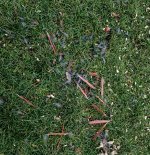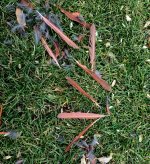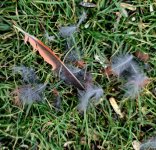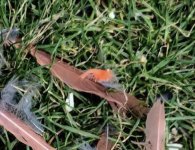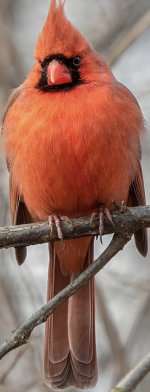There are a couple of small feathers in the photos that are clearly not wing primaries or tail feathers, and they are much brighter in color (but still orangish-brown) than the tail and wing feathers. Avery called the small feathers "body feathers", but I'm not sure where they're from - they might be coverts.
And I'm also saying that male cardinals' feathers are not nearly as red as one might naively think. There's something about how they're arranged on the live bird that makes them look redder than they do when they're laid out flat.
(thirdly, on the live bird, there's something about our brains that dials up the redness in our memory, compared to just looking at a sample of pixels. That's the zoom-in experiment I was suggesting above. But never mind, let's concentrate on the second point.)
Just look at the photos:
primary - female
primary - male
Would you have guessed that male primaries are blacker than female? Would you call any of those feathers "red"?
tail - female
tail - male
For tail feathers, the male is a little redder (or at least, more rufous) than the female, but neither of them is remotely "red".
I'm not certain, since the differences are not large enough for me to be confident in comparing the linked photos to a BirdForum post taken with a different camera in different light on a different background, but I think both the wing feathers and the tail feathers in the posting at top of thread look more like the male feathers on FeatherAtlas than like the female feathers. The body feathers are clearly not plain brown, buff, or yellowish - the usual colors of a female- so they're a better match for a male. In fairness, you sometimes do see a few quite red body feathers on females, and we've only got two or three body feathers to look at, so we can't quite rule out a female based on body feathers alone, but the probabilities are strongly in favor of male.
It's a male if there are feathers in the photo that can only have come from a male
Might as well say the converse: It's a female if there are feathers that can only have come from a female. Do you see any?




